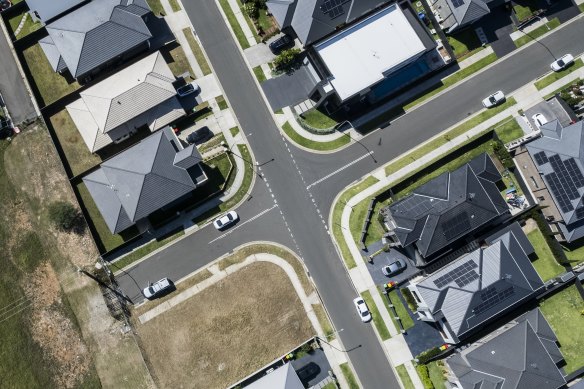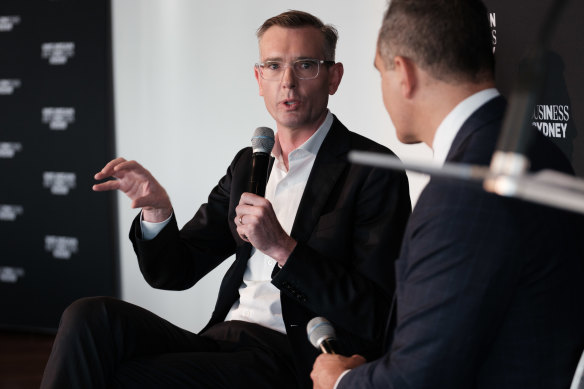- Exclusive
- Politics
- NSW
- Stamp duty
This was published 1 year ago
Perrottet’s election push to expand stamp duty reform
NSW Premier Dominic Perrottet will dramatically expand his vision to free home owners from the impost of stamp duty, under a major election pitch that will offer more upfront relief for first home buyers as they upgrade to other properties.
In one of the most significant policies to be announced by the premier before the March 25 poll, first home buyers will be allowed to continue to pay an annual tax rather than a crippling upfront stamp duty payment when they upgrade to larger and more expensive properties.

Western Sydney is leading the uptake of Perrottet’s land tax option.Credit: Brook Mitchell
The scheme would also not be limited to first homeowners who opted in to a land tax; first home buyers who bought a property and received existing stamp duty exemptions or concessions after November 11, 2022 – when the reforms became law – would also be given the option to pay an annual fee on future properties.
Perrottet’s commitment sets the stage for a high-stakes contest over housing affordability and strengthens his claim that more NSW residents would benefit under the Coalition than Labor.
“This expansion gives families more choice when buying their next home, making it easier to upsize, move closer to loved ones, or relocate for a new job or when the kids start school,” Perrotet said.
Under the laws passed in November, a first home buyer can opt in to a land tax for properties under $1.5 million and pay an annual levy of $400 plus a 0.3 per cent tax on the value of their land.
Under the Coalition’s planned expansion, the $1.5 million threshold would increase by $50,000 a year, starting in 2023-24, to ensure buyers gained a wider range of property choices as they upgraded.

“We know that stamp duty is a significant barrier to home ownership”: Premier Dominic Perrottet in Sydney on Friday.Credit: Oscar Colman
Owners would be able to hold only two properties at any given time and, if they bought a third home, they would need to pay stamp duty on the purchase price. Buyers would be able to revert to stamp duty on a future purchase if they chose.
Perrottet said his election commitment, which would cost $200 million over the next four years, was designed to give families more choice throughout their home ownership journey so they could “live in the right home at the right time of their life”.
“We know that stamp duty is a significant barrier to home ownership, particularly for young people and families trying to break into the market for the first time,” Perrottet said.
“This expansion gives families more choice when buying their next home, making it easier to upsize, move closer to loved ones, or relocate for a new job or when the kids start school.”
NSW Treasury had estimated that 6000 first home buyers a year would choose the land tax option. Since January 16, when the scheme formally started, 1460 have opted in.
The Blacktown local government area has the highest take-up, followed by Bayside, Parramatta, Sydney and Cumberland.
Under the changes passed in November, property tax rates will be indexed so the average annual payment grows at the same rate as gross state product (GSP) per capita.
However, to avoid bill shock, annual increases will be capped at 4 per cent.
Labor is opposed to the reforms, labelling the opt-in system a “forever tax on the family home”.
It has promised to ditch stamp duty for first home buyers on purchases up to $800,000 and offer a reduced rate for homes up to $1 million in a $722 million plan to counter the state government’s scheme, which Labor has vowed to axe if elected.
Labor says independent modelling by the Parliamentary Budget Office shows that within the first three years of Labor’s changes, 27,700 first home buyers across NSW would have paid no stamp duty. An additional 18,800 first homebuyers would have paid a discounted rate.
The government has seized on the high take-up of the new scheme in Labor leader Chris Minns’ council area of Bayside as proof that the opposition has ignored support for the policy.
Treasurer Matt Kean said that under the Coalition’s policy, a “family who buys their first home in western Sydney for $1 million, sells it after five years and buys their second home for $1.5 million could save more than $90,000 over their first decade as homeowners”.
The Morning Edition newsletter is our guide to the day’s most important and interesting stories, analysis and insights. Sign up here.